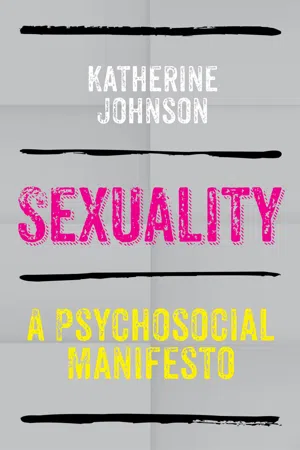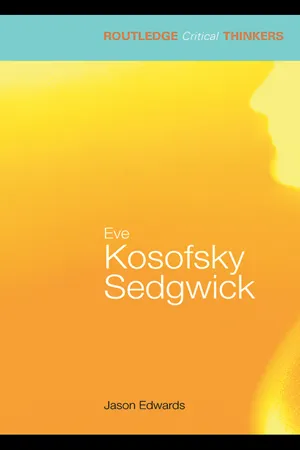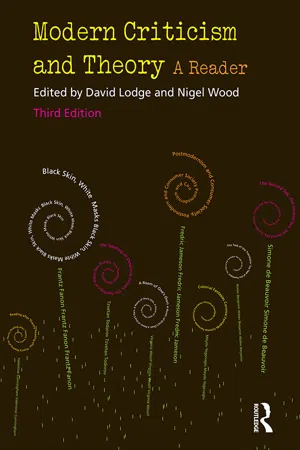Eve Kosofsky Sedgwick
Eve Kosofsky Sedgwick was a prominent literary critic and theorist known for her work in queer theory and gender studies. She is celebrated for her influential writings on the intersection of sexuality and literature, particularly her concept of "queer performativity" and her exploration of the closet as a metaphor for hidden or repressed identities. Sedgwick's work has had a lasting impact on literary and cultural studies.
7 Key excerpts on "Eve Kosofsky Sedgwick"
- eBook - ePub
Sexuality
A Psychosocial Manifesto
- Katherine Johnson(Author)
- 2015(Publication Date)
- Polity(Publisher)
...148), and she drew particular insight in her later work from the social psychologist Silvan Tomkins and the psychoanalyst Melanie Klein. As we have seen, Sedgwick was primarily concerned with developing an anti-homophobic stance, which she saw as dependent on six axioms. These can be summarized as: first, people are different from one another; second, even though gender and sexuality are related they are not coexistent and need to be untangled to understand where and how they overlap and where there is no relation; third, we cannot know in advance whether we should theorize lesbians and gay men together or separately; fourth, debates about nature versus nurture take place against an unstable fantasy of what they might explain; fifth, the search for a paradigm shift might mask the present conditions of sexual identity; sixth, the relation between gay studies and the literary canon is, and should be, tortuous. Taking these axioms as a starting point enables us to see points of connection between Sedgwick’s assumptions and that of psychology – not least in the first axiom that notes the importance of individual differences. Equally, within psychology and psychosocial studies, there are theoretical and methodological perspectives for engaging with sexuality beyond a positivist paradigm, as there are across the social sciences, which share a similar concern for how knowledge is produced. Sedgwick’s oeuvre, like most queer commentaries, uses skill in close textual analyses to illuminate alternative readings where identifications and desires of literary classics can be seen to cross gender lines. The textual turn within the social sciences, underpinned by poststructuralism also precipitated an increased awareness of the importance of close reading and analysis of discourse sought to demonstrate the relationship between language, power and representation (e.g. Potter and Wetherell, 1987; Fairclough, 1992; Hegarty, 2007)...
- eBook - ePub
- Jason Edwards(Author)
- 2008(Publication Date)
- Routledge(Publisher)
...It is, however, perhaps Proust himself who has remained the most consistently important writer in Sedgwick’s oeuvre. With Sedgwick characterising him as the ‘most vital centre’ of the ‘energies of gay literary high culture’ and of ‘many manifestations of modern literary high culture’ per se, it’s hard to imagine time better spent alongside reading Sedgwick than in reading In Search of Lost Time (E: 212). SEDGWICK’S QUEER THEORETICAL CONTEXT If you want to find out more about queer theory in general and Sedgwick’s position within it, take a look at Iain Morland and Annabelle Wilcox’s Queer Theory (2004), Nikki Sullivan’s A Critical Introduction to Queer Theory (2003), Riki Anne Wilchin’s Queer Theory, Gender Theory: An Instant Primer (2004) and Donald E. Hall’s Queer Theories (Transitions) (2002). You might also profitably work your way through Henry Abelove, Michèle Aina Barale and David M. Halperin’s The Lesbian and Gay Studies Reader (1993) and Susan Stryker and Stephen Whittle’s The Transgender Studies Reader (2006). In addition, the journal GLQ considers queer matters in a diverse array of theoretical and cultural contexts, and the recent ‘After Sex’ summer 2007 issue of the South Atlantic Quarterly is worth perusing to ascertain what happened to, or is currently happening in queer theory. Perhaps the most intelligent, concise guide to the history of queer theory and its precedents, particularly within art history, remains Whitney Davis’s ‘“Homosexualism”, Gay and Lesbian Studies, and Queer Theory in Art History’ (1998). In relation to questions of homo- and heteronormativity, Michael Warner’s Fear of a Queer Planet; Queer Politics and Social Theory (1993) is also required reading. THE HISTORY OF SEXUALITY Sedgwick has repeatedly insisted that her work cannot be read in isolation from the texts that preceded, accompanied and inspired hers...
- Maggie Humm(Author)
- 2015(Publication Date)
- Routledge(Publisher)
...Zimmerman herself tends to measure her writers against an ideal of lesbian community and self-development belonging to the 1970s, and there are other, and theoretical, lesbian methodologies. Queer Theory and Eve Kosofsky Sedgwick Currently gender studies includes work on gay, or queer theory. Eve Kosofsky Sedgwick’s Between Men (1989) and The Epistemology of the Closet (1990) offer some challenges to lesbian criticism’s generalisations about non-heterosexual experience. In these texts Sedgwick describes the literary histories of homophobia and misogyny but does not address lesbian experience directly. ‘Lesbian’ is a marked absence in both texts but Sedgwick claims that this is due to the fact that the term ‘homosocial’ used to describe women’s friendships, need not be dichotomised against homosexual (Sedgwick, 1990, p. 3). Instead, homosexual textuality is opposed to heterosexual textuality. As Sedgwick argues ‘the tensions implicit in the male-male bond are spatially connected … while the tensions of the male-female bond are temporally connected’ (Sedgwick, 1990, p. 45). There are similarities between Adrienne Rich’s notion of a lesbian continuum and Sedgwick’s characterisation of a homosocial continuum. Sedgwick is also in debt to Nancy Chodorow, Dorothy Dinnerstein and Luce Irigaray’s differing accounts of the relationship between social/cultural power and gender. Between Men wends its way from Shakespeare’s sonnets, Wycherley’s The Country Wife, Sterne’s A Sentimental Journey, the Gothic to the Victorians, Tennyson and Dickens. Epistemology of the Closet follows chronologically to examine late nineteenth- and early twentieth-century writers including Melville, James and Proust. Both books describe the ‘hidden’ topic of literature which is male bonding. Sedgwick argues that cultural constructions of homophobia occur in organisational binaries such as innocence/initiation; sincerity/sentimentality, as well as in the more obvious binaries of growth/decadence...
- eBook - ePub
Media, Gender and Identity
An Introduction
- David Gauntlett(Author)
- 2008(Publication Date)
- Routledge(Publisher)
...(Also important, within the version of queer theory which is concerned with literature rather than social identities, is the work of Eve Kosofsky Sedgwick, which challenges assumptions about sexuality in literature.) Figure 7.1 Judith Butler It is also worth mentioning that Butler is unlikely to win any awards for clarity of writing style. (On the contrary, indeed, she once won an annual international award for having produced the most incomprehensible academic text.) Her prose is unnecessarily dense and long-winded, and almost never fails to use jargon even where much more accessible vocabulary is available. Some people defend this, saying that academics should be allowed to develop complex terminology to express their sophisticated ideas – after all, nobody expects to read journals about rocket science and understand all of it straight away. However, although Butler’s writing is like an explosion in a dictionary factory, if one takes time to dig through the rubble one finds that her ideas are actually quite straightforward. So let’s get started. QUEER THEORY SUMMARY We’ll need to look at each of these points in more detail to fully understand their meaning and implications, but here’s the simple summary of what queer theory is about: Nothing within your identity is fixed. Your identity is little more than a pile of (social and cultural) things which you have previously expressed, or which have been said about you. There is not really an ‘inner self’. We come to believe we have one through the repetition of discourses about it. Gender, like other aspects of identity, is a performance (though not necessarily a consciously chosen one)...
- eBook - ePub
Regarding Sedgwick
Essays on Queer Culture and Critical Theory
- Stephen M. Barber, David L. Clark(Authors)
- 2013(Publication Date)
- Routledge(Publisher)
...“For me,” she tells us, “the ‘lesbian bardo’ is that Sedgwickian place (process? state? method?) I visit when I write from within [what Sedgwick calls] the ‘stimulating’ aether of the unnamed, the lived experiment.” No discussion of the complicating and capacious presence of “love” in Sedgwick’s work is possible now without a close engagement with A Dialogue on Love. Nancy Miller’s essay, “Reviewing Eve,” demonstrates the importance of such a reading, and she begins by acknowledging an important paradox to be found in Dialogue : The very autobiographical text that by virtue of its genre promises intimate access to the author’s identity inaugurates a new moment in its author’s intellectual itinerary, “a reluctance to return to the familiar, narrow domain of the first person.” But the essay in question from the outset implicitly problematizes the familiarity of the first person whose name is Sedgwick and thereby throws light on the degree to which any generic form undertaken by Sedgwick—love, no less—is transformed. Among the meanings of queer is “trans” or “across,” and it has functioned for Sedgwick as such especially when writing criticism in the first person. As Miller observes in her own identificatory reading of Sedgwick’s therapy memoir or intellectual autobiography, Sedgwick’s cross-identifications enact queer performativity rather than the work of the copula: Her love “with” gay men is also at times “as a gay man” (1993, 256). Sedgwick, who has written so forcefully on the emergence (sometime around the turn of the century: Wilde’s Dorian Gray is a sign post) of the conflation of desire and identification, undertakes, so Miller argues, a new queer voyage—this one having to do with how to live on in the face of a life-threatening illness. Inarguably Sedgwick, by way of desire and identification, has been doing this all along: Writing gay affirmative criticism within a murderously homophobic culture, and rememorating the forces and lives that attach to AIDS...
- eBook - ePub
- Guy Davidson, Monique Rooney(Authors)
- 2020(Publication Date)
- Routledge(Publisher)
...See Cvetkovich 168, 188; and Vaccaro. 10 In her contribution to the edited collection Regarding Sedgwick, Miller lovingly details “the craft of weaving and the practice of Buddhism” (221) as they informed Sedgwick’s tenure at the CUNY Graduate Center. See also Cohen; and Edwards 132–34. 11 For more on the blurring between the paranoid-schizoid and the reparative, see Huffer, who elegantly writes in a Foucauldian reading of Sedgwick that “the antagonistic dualisms of the mise en abyme – Foucault versus Sedgwick, paranoid versus reparative – begin to collapse in on themselves, as lovers who have been fighting often do” (39); and Hanson. 12 Wiegman gets to the heart of this matter in a recent essay: “As I read it, the problem [Sedgwick] tracks in the literary humanities throughout the 1990s is the sheer impossibility of thinking otherwise” (“Times” 23). See also Love on how “reading her work tends to open up unexpected conceptual possibilities” (235). 13 Berlant elaborates this thought in Cruel Optimism : “I love the idea of reparative reading insofar as it is a practice of meticulous curiosity. But I also resist idealizing, even implicitly, any program of better thought or reading” (124). 14 Though these two theorists are often seen in respectful opposition, there exist uncanny parallels between Bersani’s theorization of “impersonal intimacy” and Sedgwick’s notion of “the im personal” (Bersani, Is the Rectum 60). 15 See also Edwards’s observation that “since she does not have a natural facility or particularly high level of acquired skills as a textile artist, the question of her formal mastery was happily out of the question” (133). bibliography Barber, Stephen M., and David L. Clark, eds. Regarding Sedgwick: Essays on Queer Culture and Critical Theory. New York : Routledge, 2002. Print. Berlant, Lauren. Cruel Optimism. Durham, NC : Duke UP, 2011. Print. Berlant, Lauren. “Eve Sedgwick, Once More.” Critical Inquiry 35.4 (2009): 1089 – 1091...
- eBook - ePub
Modern Criticism and Theory
A Reader
- Nigel Wood, David Lodge(Authors)
- 2014(Publication Date)
- Routledge(Publisher)
...31 Eve Kosofsky Sedgwick DOI: 10.4324/9781315835488-31 Introductory note Eve Kosofsky Sedgwick is Newman Ivey White Professor of English at Duke University. Her Between Men: English literature and male homosocial desire (1985) is widely regarded as a radical text in identifying the constraints of purely heterosexual definitions of sexuality. For Sedgwick, there are a whole host of effective relations between men that are not always genetic; homosociality is not only homosexuality. She rather attempts to trace a continuum between varieties of male bonding (including more formal brotherhoods) and homosexual behaviour, not so as to base the former on the latter, but ‘rather as a strategy for making generalizations about, and marking historical differences in, the structure of men’s relations with other men’ (Between Men, p. 2). Her main focus is on English literature of the late eighteenth to the early twentieth century. (In Between Men there is just one chapter on earlier cultural formations.) The point of this choice is that there was at that time a growing emphasis on the demarcation of clear gender identities, a heterogeneity that has given rise to modern gender distinctions. This is at its strongest in realist fiction, where the power of untheorized assumptions underpins an accepted set of (usually tacit) propositions as to just what ‘reality’ may be. This silence about the inevitability of same-sex relationships (which could stop short of sexual activity) runs like a transverse section through the male-authored texts Sedgwick analyses. Representations of the physicality of women provoke unstable responses that incorporate the extremes of intense attraction/repulsion...






